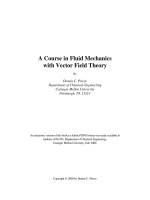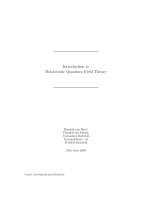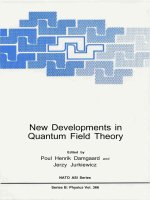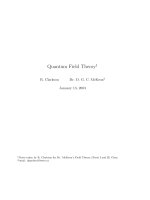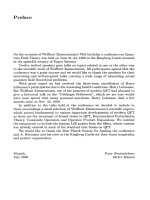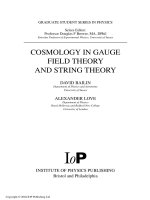- Trang chủ >>
- Khoa Học Tự Nhiên >>
- Vật lý
Radovanovic problem book in quantum field theory (1)
Bạn đang xem bản rút gọn của tài liệu. Xem và tải ngay bản đầy đủ của tài liệu tại đây (2.63 MB, 241 trang )
Problem Book Quantum Field Theory
Voja Radovanovic
Problem Book Quantum
Field Theory
ABC
Voja Radovanovic
Faculty of Physics
University of Belgrade
Studentski trg 12-16
11000 Belgrade
Yugoslavia
Library of Congress Control Number: 2005934040
ISBN-10 3-540-29062-1 Springer Berlin Heidelberg New York
ISBN-13 978-3-540-29062-9 Springer Berlin Heidelberg New York
This work is subject to copyright. All rights are reserved, whether the whole or part of the material is
concerned, specifically the rights of translation, reprinting, reuse of illustrations, recitation, broadcasting,
reproduction on microfilm or in any other way, and storage in data banks. Duplication of this publication
or parts thereof is permitted only under the provisions of the German Copyright Law of September 9,
1965, in its current version, and permission for use must always be obtained from Springer. Violations are
liable for prosecution under the German Copyright Law.
Springer is a part of Springer Science+Business Media
springeronline.com
c Springer-Verlag Berlin Heidelberg 2006
Printed in The Netherlands
The use of general descriptive names, registered names, trademarks, etc. in this publication does not imply,
even in the absence of a specific statement, that such names are exempt from the relevant protective laws
and regulations and therefore free for general use.
Typesetting: by the author and TechBooks using a Springer LATEX macro package
Cover design: design & production GmbH, Heidelberg
Printed on acid-free paper
SPIN: 11544920
56/TechBooks
543210
To my daughter Natalija
Preface
This Problem Book is based on the exercises and lectures which I have given
to undergraduate and graduate students of the Faculty of Physics, University
of Belgrade over many years. Nowadays, there are a lot of excellent Quantum
Field Theory textbooks. Unfortunately, there is a shortage of Problem Books
in this field, one of the exceptions being the Problem Book of Cheng and Li [7].
The overlap between this Problem Book and [7] is very small, since the latter
mostly deals with gauge field theory and particle physics. Textbooks usually
contain problems without solutions. As in other areas of physics doing more
problems in full details improves both understanding and efficiency. So, I feel
that the absence of such a book in Quantum Field Theory is a gap in the
literature. This was my main motivation for writing this Problem Book.
To students: You cannot start to do problems without previous studying your lecture notes and textbooks. Try to solve problems without using
solutions; they should help you to check your results. The level of this Problem Book corresponds to the textbooks of Mandl and Show [15]; Greiner and
Reinhardt [11] and Peskin and Schroeder [16]. Each Chapter begins with a
short introduction aimed to define notation. The first Chapter is devoted to
the Lorentz and Poincar´e symmetries. Chapters 2, 3 and 4 deal with the relativistic quantum mechanics with a special emphasis on the Dirac equation. In
Chapter 5 we present problems related to the Euler-Lagrange equations and
the Noether theorem. The following Chapters concern the canonical quantization of scalar, Dirac and electromagnetic fields. In Chapter 10 we consider
tree level processes, while the last Chapter deals with renormalization and
regularization.
There are many colleagues whom I would like to thank for their support
and help. Professors Milutin Blagojevi´c and Maja Buri´c gave many useful
ideas concerning problems and solutions. I am grateful to the Assistants at the
Faculty of Physics, University of Belgrade: Marija Dimitrijevi´c, Duˇsko Latas
and Antun Balaˇz who checked many of the solutions. Duˇsko Latas also drew
all the figures in the Problem Book. I would like to mention the contribution
of the students: Branislav Cvetkovi´c, Bojan Nikoli´c, Mihailo Vanevi´c, Marko
VIII
Preface
Vojinovi´c, Aleksandra Stojakovi´c, Boris Grbi´c, Igor Salom, Irena Kneˇzevi´c,
Zoran Ristivojevi´c and Vladimir Juriˇci´c. Branislav Cvetkovi´c, Maja Buri´c,
Milutin Blagojevi´c and Dejan Stojkovi´c have corrected my English translation
of the Problem Book. I thank them all, but it goes without saying that all
the errors that have crept in are my own. I would be grateful for any readers’
comments.
Belgrade, August 2005
Voja Radovanovi´c
Contents
Part I Problems
1
Lorentz and Poincar´
e symmetries . . . . . . . . . . . . . . . . . . . . . . . . . .
3
2
The Klein–Gordon equation . . . . . . . . . . . . . . . . . . . . . . . . . . . . . . .
9
3
The γ–matrices . . . . . . . . . . . . . . . . . . . . . . . . . . . . . . . . . . . . . . . . . . . . 13
4
The Dirac equation . . . . . . . . . . . . . . . . . . . . . . . . . . . . . . . . . . . . . . . . 17
5
Classical field theory and symmetries . . . . . . . . . . . . . . . . . . . . . 25
6
Green functions . . . . . . . . . . . . . . . . . . . . . . . . . . . . . . . . . . . . . . . . . . . 31
7
Canonical quantization of the scalar field . . . . . . . . . . . . . . . . . . 35
8
Canonical quantization of the Dirac field . . . . . . . . . . . . . . . . . . 43
9
Canonical quantization of the electromagnetic field . . . . . . . . 49
10 Processes in the lowest order of perturbation theory . . . . . . . 55
11 Renormalization and regularization . . . . . . . . . . . . . . . . . . . . . . . . 61
Part II Solutions
1
Lorentz and Poincar´
e symmetries . . . . . . . . . . . . . . . . . . . . . . . . . . 67
2
The Klein–Gordon equation . . . . . . . . . . . . . . . . . . . . . . . . . . . . . . . 77
3
The γ–matrices . . . . . . . . . . . . . . . . . . . . . . . . . . . . . . . . . . . . . . . . . . . . 85
X
Contents
4
The Dirac equation . . . . . . . . . . . . . . . . . . . . . . . . . . . . . . . . . . . . . . . . 93
5
Classical fields and symmetries . . . . . . . . . . . . . . . . . . . . . . . . . . . . 121
6
Green functions . . . . . . . . . . . . . . . . . . . . . . . . . . . . . . . . . . . . . . . . . . . 131
7
Canonical quantization of the scalar field . . . . . . . . . . . . . . . . . 141
8
Canonical quantization of the Dirac field . . . . . . . . . . . . . . . . . . 161
9
Canonical quantization of the electromagnetic field . . . . . . . . 179
10 Processes in the lowest order of the perturbation theory . . . 191
11 Renormalization and regularization . . . . . . . . . . . . . . . . . . . . . . . . 211
References . . . . . . . . . . . . . . . . . . . . . . . . . . . . . . . . . . . . . . . . . . . . . . . . . . . . . 239
Index . . . . . . . . . . . . . . . . . . . . . . . . . . . . . . . . . . . . . . . . . . . . . . . . . . . . . . . . . . 241
Part I
Problems
1
Lorentz and Poincar´
e symmetries
• Minkowski space, M4 is a real 4-dimensional vector space with metric tensor
defined by
1 0
0
0
0
0 −1 0
gµν =
(1.A)
.
0 0 −1 0
0 0
0 −1
Vectors can be written in the form x = xµ eµ , where xµ are the contravariant
components of the vector x in the basis
1
0
0
0
0
1
0
0
e0 = , e1 = , e2 = , e3 = .
0
0
1
0
0
0
0
1
The square of the length of a vector in M4 is x2 = gµν xµ xν . The square of
the line element between two neighboring points xµ and xµ + dxµ takes the
form
(1.B)
ds2 = gµν dxµ dxν = c2 dt2 − dx2 .
The space M4 is also a manifold; xµ are global (inertial) coordinates. The
covariant components of a vector are defined by xµ = gµν xν .
• Lorentz transformations,
(1.C)
x µ = Λµν xν ,
leave the square of the length of a vector invariant, i.e. x 2 = x2 . The matrix Λ
is a constant matrix1 ; xµ and x µ are the coordinates of the same event in two
different inertial frames. In Problem 1.1 we shall show that from the previous
definition it follows that the matrix Λ must satisfy the condition ΛT gΛ = g.
The transformation law of the covariant components is given by
xµ = (Λ−1 )νµ xν = Λµν xν .
1
(1.D)
The first index in Λµν is the row index, the second index the column index.
4
Problems
• Let u = uµ eµ be an arbitrary vector in tangent space2 , where uµ are its
contravariant components. A dual space can be associated to the vector space
in the following way. The dual basis, θ µ is determined by θ µ (eν ) = δνµ . The
vectors in the dual space, ω = ωµ θ µ are called dual vectors or one–forms.
The components of the dual vector transform like (1.D). The scalar (inner)
product of vectors u and v is given by
u · v = gµν uµ v ν = uµ vµ .
A tensor of rank (m, n) in Minkowski spacetime is
T = T µ1 ...µm ν1 ...νn (x)eµ1 ⊗ . . . ⊗ eµm ⊗ θ ν1 ⊗ . . . ⊗ θ νn .
The components of this tensor transform in the following way
T
µ1 ...µm
n1 ...νn (x
σn
) = Λµ1 ρ1 . . . Λµm ρm (Λ−1 )σ1 ν1 . . . (Λ−1 )νn T ρ1 ...ρm σ1 ...σn (x) ,
under Lorentz transformations. A contravariant vector is tensor of rank (1, 0),
while the rank of a covariant vector (one-form) is (0, 1). The metric tensor is
a symmetric tensor of rank (0, 2).
• Poincar´e transformations,3 (Λ, a) consist of Lorentz transformations and
translations, i.e.
(Λ, a)x = Λx + a .
(1.E)
These are the most general transformations of Minkowski space which do not
change the interval between any two vectors, i.e.
(y − x )2 = (y − x)2 .
• In a certain representation the elements of the Poincar´e group near the identity
are
µν
µ
i
(1.F)
U (ω, ) = e− 2 Mµν ω +iPµ ,
where ω µν and Mµν are parameters and generators of the Lorentz subgroup
respectively, while µ and Pµ are the parameters and generators of the translation subgroup. The Poincar´e algebra is given in Problem 1.11.
• The Levi-Civita tensor, µνρσ is a totaly antisymmetric tensor. We will use
the convention that 0123 = +1.
2
3
The tangent space is a vector space of tangent vectors associated to each point
of spacetime.
Poincar´e transformations are very often called inhomogeneous Lorentz transformations.
Chapter 1. Lorentz and Poincare symmetries
5
1.1. Show that Lorentz transformations satisfy the condition ΛT gΛ = g. Also,
prove that they form a group.
1.2. Given an infinitesimal Lorentz transformation
Λµ ν = δ µ ν + ω µ ν ,
show that the infinitesimal parameters ωµν are antisymmetric.
1.3. Prove the following relation
α
β
γ
δ
αβγδ A µ A ν A λ A σ
=
µνλσ detA
,
where Aα µ are matrix elements of the matrix A.
1.4. Show that the Kronecker δ symbol and Levi-Civita
invariant under Lorentz transformations.
symbol are form
1.5. Prove that
µνρσ
αβγδ
δµα
δν
= − ρα
δ α
δσ α
δµ β
δν β
δρβ
δσ β
and calculate the following contractions
µνρσ
µνρσ .
δµ γ
δν γ
δργ
δσ γ
µνρσ
δµ δ
δν δ
δρδ
δσ δ
µβγδ ,
,
µνρσ
µνρσ
µνγδ ,
µνρδ ,
¯ µ = (I, −σ), where I is a
1.6. Let us introduce the notations σ µ = (I, σ); σ
4
unit matrix, while σ are Pauli matrices and define the matrix X = xµ σ µ .
(a) Show that the transformation
X → X = SXS † ,
where S ∈ SL(2, C)5 , describes the Lorentz transformation xµ → Λµν xν .
This is a homomorphism between proper orthochronous Lorentz transformations6 and the SL(2, C) group.
σ µ X).
(b) Show that xµ = 12 tr(¯
σ µ Sσν S † ), and Λ(S) = Λ(−S). The last relation
1.7. Prove that Λµ ν = 12 tr(¯
shows that the map is not unique.
4
The Pauli matrices are
σ1 =
5
6
0
1
1
0
,
σ2 =
0
i
−i
0
and
σ3 =
1
0
0
−1
.
SL(2, C) matrices are 2 × 2 complex matrices of unit determinant.
The proper orthochronous Lorentz transformations satisfy the conditions: Λ00 ≥
1, detΛ = 1.
6
Problems
1.8. Find the matrix elements of generators of the Lorentz group Mµν in its
natural (defining) representation (1.C).
1.9. Prove that the commutation relations of the Lorentz algebra
[Mµν , Mρσ ] = i(gµσ Mνρ + gνρ Mµσ − gµρ Mνσ − gνσ Mµρ )
lead to
[Mi , Mj ] = i
ijl Ml ,
[Ni , Nj ] = −i
ijl Nl ,
[Mi , Nj ] = i
ijl Nl
,
where Mi = 12 ijk Mjk and Nk = Mk0 . Further, one can introduce the following
linear combinations Ai = 12 (Mi + iNi ) and Bi = 12 (Mi − iNi ). Prove that
[Ai , Aj ] = i
ijl Al ,
[Bi , Bj ] = i
ijl Bl ,
[Ai , Bj ] = 0 .
This is a well known result which gives a connection between the Lorentz
algebra and ”two” SU(2) algebras. Irreducible representations of the Lorentz
group are classified by two quantum numbers (j1 , j2 ) which come from above
two SU(2) groups.
1.10. The Poincar´e transformation (Λ, a) is defined by:
x µ = Λµ ν xν + aµ .
Determine the multiplication rule i.e. the product (Λ1 , a1 )(Λ2 , a2 ), as well as
the unit and inverse element in the group.
1.11. (a) Verify the multiplication rule
U −1 (Λ, 0)U (1, )U (Λ, 0) = U (1, Λ−1 ) ,
in the Poincar´e group. In addition, show that from the previous relation
follows:
U −1 (Λ, 0)Pµ U (Λ, 0) = (Λ−1 )ν µ Pν .
Calculate the commutator [Mµν , Pρ ].
(b) Show that
U −1 (Λ, 0)U (Λ , 0)U (Λ, 0) = U (Λ−1 Λ Λ, 0) ,
and find the commutator [Mµν , Mρσ ].
(c) Finally show that the generators of translations commute between themselves, i.e. [Pµ , Pν ] = 0.
1.12. Consider the representation in which the vectors x of Minkowski space
are (x, 1)T , while the element of the Poincar´e group, (Λ, a) are 5 × 5 matrices
given by
Λ a
.
0 1
Check that the generators in this representation satisfy the commutation relations from the previous problem.
Chapter 1. Lorentz and Poincare symmetries
7
1.13. Find the generators of the Poincar´e group in the representation of a classical scalar field7 . Prove that they satisfy the commutation relations obtained
in Problem 1.11.
1.14. The Pauli–Lubanski vector is defined by Wµ =
1
νλ σ
P .
2 µνλσ M
(a) Show that Wµ P µ = 0 and [Wµ , Pν ] = 0.
(b) Show that W 2 = − 12 Mµν M µν P 2 + Mµσ M νσ P µ Pν .
(c) Prove that the operators W 2 and P 2 commute with the generators of the
Poincar´e group. These operators are Casimir operators. They are used to
classify the irreducible representations of the Poincar´e group.
1.15. Show that
W 2 |p = 0, m, s, σ = −m2 s(s + 1)|p = 0, m, s, σ ,
where |p = 0, m, s, σ is a state vector for a particle of mass m, momentum
p, spin s while σ is the z–component of the spin. The mass and spin classify
the irreducible representations of the Poincar´e group.
1.16. Verify the following relations
(a) [Mµν , Wσ ] = i(gνσ Wµ − gµσ Wν ) ,
(b) [Wµ , Wν ] = −i µνσρ W σ P ρ .
1.17. Calculate the commutators
(a) [Wµ , M 2 ] ,
(b) [Mµν , W µ W ν ] ,
(c) [M 2 , Pµ ] ,
(d) [ µνρσ Mµν Mρσ , Mαβ ] .
1.18. The standard momentum for a massive particle is (m, 0, 0, 0), while for
a massless particle it is (k, 0, 0, k). Show that the little group in the first case
is SU(2), while in the second case it is E(2) group8 .
1.19. Show that conformal transformations consisting of dilations:
xµ → x µ = e−ρ xµ ,
special conformal transformations (SCT):
xµ → x µ =
xµ + cµ x2
,
1 + 2c · x + c2 x2
and usual Poincar´e transformations form a group. Find the commutation relations in this group.
7
8
Scalar field transforms as φ (Λx + a) = φ(x)
E(2) is the group of rotations and translations in a plane.
2
The Klein–Gordon equation
• The Klein–Gordon equation,
( + m2 )φ(x) = 0,
(2.A)
is an equation for a free relativistic particle with zero spin. The transformation
law of a scalar field φ(x) under Lorentz transformations is given by φ (Λx) =
φ(x).
• The equation for the spinless particle in an electromagnetic field, Aµ is obtained by changing ∂µ → ∂µ + iqAµ in equation (2.A), where q is the charge
of the particle.
2.1. Solve the Klein–Gordon equation.
2.2. If φ is a solution of the Klein–Gordon equation calculate the quantity
Q = iq
d3 x φ∗
∂φ∗
∂φ
−φ
∂t
∂t
.
2.3. The Hamiltonian for a free real scalar field is
1
d3 x[(∂0 φ)2 + (∇φ)2 + m2 φ2 ] .
H=
2
Calculate the Hamiltonian H for a general solution of the Klein–Gordon equation.
2.4. The momentum for a real scalar field is given by
P=−
d3 x∂0 φ∇φ .
Calculate the momentum P for a general solution of the Klein–Gordon equation.
10
Problems
2.5. Show that the current1
i
jµ = − (φ∂µ φ∗ − φ∗ ∂µ φ)
2
satisfies the continuity equation, ∂ µ jµ = 0.
2.6. Show that the continuity equation ∂µ j µ = 0 is satisfied for the current
i
jµ = − (φ∂µ φ∗ − φ∗ ∂µ φ) − qAµ φ∗ φ ,
2
where φ is a solution of Klein–Gordon equation in external electromagnetic
potential Aµ .
2.7. A scalar particle in the s–state is moving in the potential
qA0 =
−V, r < a
,
0,
r>a
where V is a positive constant. Find the dispersion relation, i.e. the relation
between energy and momentum, for discrete particle states. Which condition
has to be satisfied so that there is only one bound state in the case V < 2m?
2.8. Find the energy spectrum and the eigenfunctions for a scalar particle in
a constant magnetic field, B = Bez .
2.9. Calculate the reflection and the transmission coefficients of a Klein–
Gordon particle with energy E, at the potential
A0 =
0,
U0 ,
z<0
,
z>0
where U0 is a positive constant.
2.10. A particle of charge q and mass m is incident on a potential barrier
A0 =
0,
z < 0, z > a
,
U0 , 0 < z < a
where U0 is a positive constant. Find the transmission coefficient.
2.11. A scalar particle of mass m and charge −e moves in the Coulomb field
of a nucleus. Find the energy spectrum of the bounded states for this system
if the charge of the nucleus is Ze.
θ
, where θ = 12 (φ + mi ∂φ
∂t )
χ
and χ = 12 (φ − mi ∂φ
∂t ), instead of φ rewrite the Klein–Gordon equation in the
Schr¨
odinger form.
2.12. Using the two-component wave function
1
Actually this is current density.
Chapter 2. The Klein–Gordon equation
11
2.13. Find the eigenvalues of the Hamiltonian from the previous problem.
Find the nonrelativistic limit of this Hamiltonian.
2.14. Determine the velocity operator v = i[H, x], where H is the Hamiltonian
obtained in Problem 2.12. Solve the eigenvalue problem for v.
2.15. In the space of two–component wave functions the scalar product is
defined by
1
ψ1 |ψ2 =
d3 xψ1† σ3 ψ2 .
2
(a) Show that the Hamiltonian H obtained in Problem 2.12 is Hermitian.
(b) Find expectation values of the Hamiltonian H , and the velocity v in
1
the state
e−ip·x .
0
3
The γ–matrices
• In Minkowski space M4 , the γ–matrices satisfy the anticommutation relations 1
{γ µ , γ ν } = 2g µν .
(3.A)
• In the Dirac representation γ–matrices take the form
γ0 =
I
0
0
−I
,
0
−σ
γ=
σ
0
.
(3.B)
Other representations of the γ–matrices can be obtained by similarity transformation γµ = Sγµ S −1 . The transformation matrix S need to be unitary if the transformed matrices are to satisfy the Hermicity condition:
(γ µ )† = γ 0 γ µ γ 0 . The Weyl representation of the γ–matrices is given by
γ0 =
0 I
I 0
,
γ=
0
−σ
σ
0
,
(3.C)
while in the Majorana representation we have
γ0 =
γ2 =
0
σ2
0
σ2
σ2
0
,
γ1 =
iσ3
0
−σ2
0
,
γ3 =
−iσ1
0
0
iσ3
,
0
−iσ1
(3.D)
.
• The matrix γ 5 is defined by γ 5 = iγ 0 γ 1 γ 2 γ 3 , while γ5 = −iγ0 γ1 γ2 γ3 . In the
Dirac representation, γ5 has the form
γ5 =
1
0
I
I
0
.
The same type of relations hold in Md , where d is the dimension of spacetime.
14
Problems
• σµν matrices are defined by
σµν =
• Slash is defined as
i
[γµ , γν ] .
2
(3.E)
/a = aµ γµ .
(3.F)
• Sometimes we use the notation: β = γ , α = γ γ. The anticommutation
relations (3.A) become
0
0
{αi , αj } = 2δ ij , {αi , β} = 0 .
3.1. Prove:
(a) 㵆 = γ 0 γµ γ 0 ,
†
= γ 0 σµν γ 0 .
(b) σµν
3.2. Show that:
(a) γ5† = γ5 = γ 5 = γ5−1 ,
(b) γ5 = − 4!i µνρσ γ µ γ ν γ ρ γ σ ,
(c) (γ5 )2 = 1 ,
(d) (γ5 γµ )† = γ 0 γ5 γµ γ 0 .
3.3. Show that:
(a) {γ5 , γ µ } = 0 ,
(b) [γ5 , σ µν ] = 0 .
3.4. Prove a
/2 = a2 .
3.5. Derive the following identities with contractions of the γ–matrices:
(a) γµ γ µ = 4 ,
(b) γµ γ ν γ µ = −2γ ν ,
(c) γµ γ α γ β γ µ = 4g αβ ,
(d) γµ γ α γ β γ γ γ µ = −2γ γ γ β γ α ,
(e) σ µν σµν = 12 ,
(f) γµ γ5 γ µ γ 5 = −4 ,
(g) σαβ γµ σ αβ = 0 ,
(h) σαβ σ µν σ αβ = −4σ µν ,
(i) σ αβ γ 5 γ µ σαβ = 0 ,
(j) σ αβ γ 5 σαβ = 12γ 5 .
Chapter 3. The γ–matrices
15
3.6. Prove the following identities with traces of γ–matrices:
(a) trγµ = 0 ,
(b) tr(γµ γν ) = 4gµν ,
(c) tr(γµ γν γρ γσ ) = 4(gµν gρσ − gµρ gνσ + gµσ gνρ ) ,
(d) trγ5 = 0 ,
(e) tr(γ5 γµ γν ) = 0 ,
(f) tr(γ5 γµ γν γρ γσ ) = −4i µνρσ ,
a2n+1 ) = 0 ,
(g) tr(/
a1 · · · /
a2n ) = tr(/
a2n · · · /a1 ) ,
(h) tr(/
a1 · · · /
(i) tr(γ5 γµ ) = 0 ,
a2 · · · /
a6 ).
3.7. Calculate tr(/a1 /
3.8. Calculate tr[(/
p − m)γµ (1 − γ5 )(/
q + m)γν ].
3.9. Calculate γµ (1 − γ5 )(/
p − m)γ µ .
3.10. Verify the identity
exp(γ5 /
a) = cos
aµ aµ + √
1
γ5 /a sin
aµ aµ
aµ aµ ,
where a2 > 0 .
3.11. Show that the set
Γ a = {I, γ µ , γ 5 , γ µ γ 5 , σ µν } ,
is made of linearly independent 4 × 4 matrices. Also, show that the product
of any two of them is again one of the matrices Γ a , up to ±1, ±i.
3.12. Show that any matrix A ∈ C 44 can be written in terms of Γ a =
{I, γ µ , γ 5 , γ µ γ 5 , σ µν }, i.e. A = a ca Γ a where ca = 14 tr(AΓa ).
3.13. Expand the following products of γ–matrices in terms of Γ a :
(a) γµ γν γρ ,
(b) γ5 γµ γν ,
(c) σµν γρ γ5 .
3.14. Expand the anticommutator {γ µ , σ νρ } in terms of Γ –matrices.
3.15. Calculate tr(γµ γν γρ γσ γa γβ γ5 ).
3.16. Verify the relation γ5 σ µν =
i µνρσ
σρσ .
2
3.17. Show that the commutator [σµν , σρσ ] can be rewritten in terms of σµν .
Find the coefficients in this expansion.
16
Problems
3.18. Show that if a matrix commutes with all gamma matrices γ µ , then it is
proportional to the unit matrix.
3.19. Let U = exp(βα · n), where β and α are Dirac matrices; n is a unit
vector. Verify the following relation:
α ≡ U αU † = α − (I − U 2 )(α · n)n .
3.20. Show that the set of matrices (3.C) is a representation of γ–matrices.
Find the unitary matrix which transforms this representation into the Dirac
one. Calculate σµν , and γ5 in this representation.
3.21. Find Dirac matrices in two dimensional spacetime. Define γ5 and calculate
tr(γ 5 γ µ γ ν ) .
Simplify the product γ 5 γ µ .
4
The Dirac equation
• The Dirac equation,
(iγ µ ∂µ − m)ψ(x) = 0 ,
(4.A)
is an equation of the free relativistic particle with spin 1/2. The general solution of this equation is given by
ψ(x) =
2
1
(2π)
3
2
d3 p
r=1
m
ur (p)cr (p)e−ip·x + vr (p)d†r (p)eip·x
Ep
, (4.B)
where ur (p) and vr (p) are the basic bispinors which satisfy equations
(/
p − m)ur (p) = 0 ,
(/
p + m)vr (p) = 0 .
(4.C)
We use the normalization
u
¯r (p)us (p) = −¯
vr (p)vs (p) = δrs ,
u
¯r (p)vs (p) = v¯r (p)us (p) = 0.
(4.D)
The coefficients cr (p) and dr (p) in (4.B) being given determined by boundary
conditions. Equation (4.A) can be rewritten in the form
i
∂ψ
= HD ψ ,
∂t
where HD = α · p + βm is the so-called Dirac Hamiltonian.
• Under the Lorentz transformation, x µ = Λµ ν xν , Dirac spinor, ψ(x) transforms as
i µν
(4.E)
ψ (x ) = S(Λ)ψ(x) = e− 4 σ ωµν ψ(x) .
S(Λ) is the Lorentz transformation matrix in spinor representation, and it
satisfies the equations:
S −1 (Λ) = γ0 S † (Λ)γ0 ,
18
Problems
S −1 (Λ)γ µ S(Λ) = Λµ ν γ ν .
• The equation for an electron with charge −e in an electromagnetic field Aµ is
given by
(4.F)
[iγ µ (∂µ − ieAµ ) − m] ψ(x) = 0 .
• Under parity, Dirac spinors transform as
ψ(t, x) → ψ (t, −x) = γ0 ψ(t, x) .
(4.G)
• Time reversal is an antiunitary operation:
ψ(t, x) → ψ (−t, x) = T ψ ∗ (t, x) .
The matrix T , satisfies
T γµ T −1 = γ µ∗ = γµT .
(4.H)
(4.I)
The solution of the above condition is T = iγ 1 γ 3 , in the Dirac representation
of γ–matrices. It is easy to see that T † = T −1 = T = −T ∗ .
• Under charge conjugation, spinors ψ(x) transform as follows
ψ(x) → ψc (x) = C ψ¯T .
(4.J)
The matrix C satisfies the relations:
Cγµ C −1 = −γµT ,
C −1 = C T = C † = −C .
(4.K)
In the Dirac representation, the matrix C is given by C = iγ 2 γ 0 .
4.1. Find which of the operators given below commute with the Dirac Hamiltonian:
(a) p = −i∇ ,
(b) L = r × p ,
(c) L2 ,
(d) S = 12 Σ , where Σ = 2i γ × γ ,
(e) J = L + S ,
(f) J2 ,
p
,
(g) Σ · |p|
(h) Σ · n, where n is a unit vector.
4.2. Solve the Dirac equation for a free particle, i.e. derived (4.B).
4.3. Find the energy of the states us (p)e−ip·x and vs (p)eip·x for the Dirac
particle.
Chapter 4. The Dirac equation
19
4.4. Using the solution of Problem 4.2 show that
2
ur (p)¯
ur (p) =
r=1
/p + m
≡ Λ+ (p) ,
2m
2
vr (p)¯
vr (p) = −
−
r=1
/p − m
≡ Λ− (p) .
2m
The quantities Λ+ (p) and Λ− (p) are energy projection operators.
4.5. Show that Λ2± = Λ± , and Λ+ Λ− = 0. How do these projectors act on the
basic spinors ur (p) and vr (p)? Derive these results with and without using
explicit expressions for spinors.
4.6. The spin operator in the rest frame for a Dirac particle is defined by
S = 12 Σ. Prove that:
(a) Σ = γ5 γ0 γ ,
(b) [S i , S j ] = i ijk S k ,
(c) S 2 = − 34 .
4.7. Prove that:
Σ·p
ur (p) = (−1)r+1 ur (p) ,
|p|
Σ·p
vr (p) = (−1)r vr (p) .
|p|
Are spinors ur (p) and vr (p) eigenstates of the operator Σ · n, where n is a
unit vector? Check the same property for the spinors in the rest frame.
4.8. Find the boost operator for the transition from the rest frame to the
frame moving with velocity v along the z–axis, in the spinor representation.
Is this operator unitary?
4.9. Solve the previous problem upon transformation to the system rotated
around the z–axis for an angle θ. Is this operator a unitary one?
4.10. The Pauli–Lubanski vector is defined by Wµ = 12 µνρσ M νρ P σ , where
M νρ = 12 σ νρ + i(xν ∂ ρ − xρ ∂ ν ) is angular momentum, while P µ is linear momentum. Show that
1
1
W 2 ψ(x) = − (1 + )m2 ψ(x) ,
2
2
where ψ(x) is a solution of the Dirac equation.
20
Problems
4.11. The covariant operator which projects the spin operator onto an arbitrary normalized four-vector sµ (s2 = −1) is given by Wµ sµ , where s · p = 0,
i.e. the vector polarization sµ is orthogonal to the momentum vector. Show
that
Wµ sµ
1
=
γ5 /s/p .
m
2m
Find this operator in the rest frame.
4.12. In addition to the spinor basis, one often uses the helicity basis. The
helicity basis is obtained by taking n = p/|p| in the rest frame. Find the
equations for the spin in this case.
4.13. Find the form of the equations for the spin, defined in Problem 4.12 in
the ultrarelativistic limit.
4.14. Show that the operator γ5 /s commutes with the operator /p, and that the
eigenvalues of this operator are ±1. Find the eigen-projectors of the operator
s. Prove that these projectors commute with projectors onto positive and
γ5 /
negative energy states, Λ± (p).
4.15. Consider a Dirac’s particle moving along the z–axis with momentum p.
The nonrelativistic spin wave function is given by
ϕ=
1
|a|2
+ |b|2
a
b
.
Calculate the expectation value of the spin projection onto a unit vector n,
i.e. Σ · n . Find the nonrelativistic limit.
4.16. Find the Dirac spinor for an electron moving along the z−axis with
momentum p. The electron is polarized along the direction n = (θ, φ = π2 ).
Calculate the expectation value of the projection spin on the polarization
vector in that state.
4.17. Is the operator γ5 a constant of motion for the free Dirac particle? Find
the eigenvalues and projectors for this operator.
4.18. Let us introduce
1
(1 − γ5 )ψ ,
2
1
ψR = (1 + γ5 )ψ ,
2
where ψ is a Dirac spinor. Derive the equations of motion for these fields.
Show that they are decoupled in the case of a massless spinor. The fields ψL
ψR are known as Weyl fields.
ψL =
